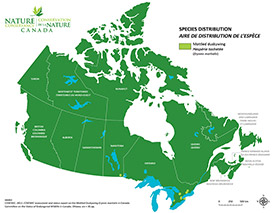
A mottled duskywing sits on a prairie redroot plant (Photo by NCC)
Mottled duskywing
What does it look like?
A medium-sized butterfly of the skipper family, this species has a wingspan between 20 and 30 millimetres and a dark grey/brown body. It has yellow-brown spots on its hind wings, which distinguish it from other duskywing species. The wings of freshly emerged adults have a purplish hue.
What is its range and habitat?
Mottled duskywings are found in small, local populations throughout eastern and central United States, Ontario and Manitoba. The species is extirpated (locally extinct) in Quebec, and severe population declines have been observed in many places in the U.S. It does not migrate and remains in the same habitat throughout its life cycle.
Like many butterflies, the mottled duskywing is selective about where it lives and what it eats. In Manitoba, the larvae feed on prairie redroot. In Ontario, the species also feeds on the closely related New Jersey tea. These plants are usually found in dry habitats, such as tall grass prairie and oak savannah.
What is its conservation status?
In 2012, the Committee on the Status of Endangered Wildlife in Canada assessed the mottled duskywing as endangered. It is rare in Ontario and Manitoba, and already gone from Quebec. The Province of Ontario announced a recovery strategy in 2015, which aims to manage threats to mottled duskywing habitat and stabilize the population.
The mottled duskywing is the only oak savannah specialist butterfly left in Ontario. Two other savannah species, frosted elfin and Karner blue, are now gone.
Friendly fire
Perhaps surprisingly, suppression of naturally occurring fire threatens the mottled duskywing’s habitat. Fire limits the growth of species that crowd out the plants that the mottled duskywing relies on. Shrubs, trees and invasive plants can crowd out native species if unchecked, changing grasslands and savannahs into forests. The Nature Conservancy of Canada (NCC), under certain conditions, uses prescribed burns to help protect and reclaim these areas.
Rice Lake Plains
The tall grass landscape survives in the Rice Lake Plains Natural Area in southern Ontario, about an hour east of Toronto. Since 2002, NCC has helped lead the Rice Lake Plains Partnership (RLPP). The RLPP is a collective made up of landowners, members of the Alderville First Nation, government and conservation groups, that works to protect this area of sandy hills, oak savannahs and grasslands.
With the support of hardworking volunteers, NCC and the RLPP are fighting against invasive species, such as Scotch pine, through the use of cutting, uprooting and controlled burns. Seeding and planting projects are helping establish more prairie and oak savannah.
NCC has mapped New Jersey tea in this area and helped organize volunteers for an annual butterfly count. Fewer than 10 mottled duskywings were surveyed on NCC properties in the Rice Lake Plains in both 2018 and 2019. In 2019, students at Fleming College completed a mottled duskywing recovery strategy for the Rice Lake Plains, in partnership with RLPP. The strategy emphasizes the recovery of New Jersey tea in the Rice Lake Plains Natural Area.
In 2021, there were a total of 124 mottled duskywing sighted on NCC properties in the Rice Lake Plains.
With cooperation between partners and communities, the Rice Lake Plains Natural Area shows the difference we can make when we work together to protect our most vulnerable species and landscapes.
Southern Norfolk Sand Plain Natural Area
Norfolk County is a biodiversity hot spot and part of the Carolinian Life Zone, which extends north from the Carolinas to southwestern Ontario. Within this region, numerous habitat types occur, including forests, ravines and floodplains, globally rare coastal dunes and beaches, and internationally significant wetlands.
NCC is partnering with researchers and conservation professionals to prepare a mottled duskywing recovery plan for the Backus Woods area. This includes restoring former agricultural sites into grassland habitat featuring New Jersey tea, as well as removing invasive species, and seeding native plants. This work will continue into 2024 with the release of mottled duskywing at the prepared sites.





